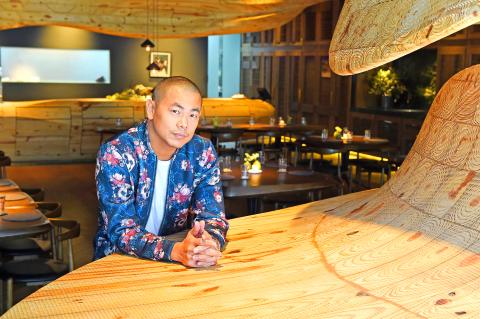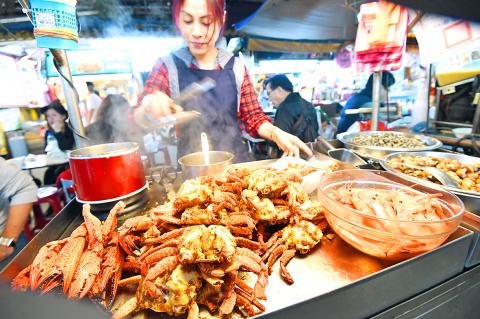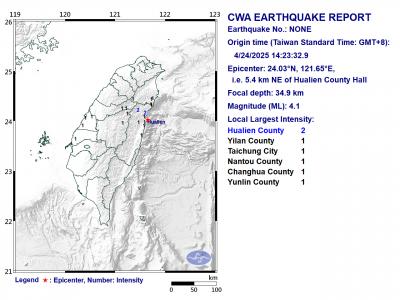Pungent slices of fermented tofu, piping hot pork buns and crisp green guava slices are some of Taiwan’s classic street eats, with the best stalls attracting lines of locals and visitors.
Now these no-frills favorites are being joined by a new wave of restaurants tapping into the island’s abundant fresh produce and vibrant cuisine.
Their fusion of seasonal menus and slick interiors at modest prices is starting to create an international buzz — Conde Nast Traveller magazine has labeled Taiwan as the “foodie destination of 2015.”

Photo: AFP
The nation’s star chef, Andre Chiang (江振誠) — who trained in France and runs the acclaimed Restaurant Andre in Singapore — recently opened his first venue on home turf, RAW, in northern Taipei.
It serves up seasonal Taiwanese produce crafted into what Chiang calls a “new interpretation” of the island’s culinary traditions.
“They are all humble ingredients — but when you start to match them in a different way, you create something interesting,” he said.

Photo: AFP
RAW’s seven-course menu changes every month and features 21 Taiwanese ingredients in peak season at the time.
Tiny shrimp nestle inside purple rice crackers; three types of cauliflower are layered onto thin wafers of chicken skin; a version of the island’s famed sweet treat, the pineapple cake, is presented as three semi-frozen cubes.
The full tasting menu costs NT$1,850, which Chiang calls “accessible” compared with the nation’s more expensive fine-dining options, mostly the preserve of high-end hotels.

Photo: AFP
RAW, which opened in December last year, is part of 38-year-old Chiang’s mission to help carve out a fresh global identity for Taiwan.
“We used to be Taiwanese, with Aboriginal local cuisine, then we were colonized for 50 years by the Japanese, then there was the takeover by the Chinese government. We can’t cut [those influences] out of our history,” he said.
Now entrepreneurial restaurateurs are finding their feet, and it is not just about the food.
“Small independent restaurants ... are starting to take Taiwanese local produce and are doing it in a more international way, with both the cuisine and the design,” Chiang said.
The cavernous space at RAW, designed by Dutch architect Camiel Weijenberg, is dominated by two huge curved wooden counters made from Taiwanese spruce by local artisans.
The city’s growing reputation for creativity led Taipei to be named World Design Capital for next year by the International Council of the Societies of Industrial Design.
“People have studied abroad and are bringing ideas back with them — a lot has changed in the last year or two ... there’s a big transition at the moment,” Weijenberg said.
At new restaurant Mume, three young chefs use Taiwanese produce to create Western dishes in a bid to fill the gap between simple island fare and pricey fine dining.
The cosy 32-seat venue decked out in dark wood and storm lamps also opened in December last year, tucked away in a quiet street in Taipei’s Daan District (大安).
“We’re starting to get quite a lot of international travelers, probably 20 to 30 percent,” said Hong Kong-born founder and chef Richie Lin, 34, who works with Australian chef Kai Ward, 24, and US chef Long Xiong, 32.
Mume serves up plates designed for sharing, from grilled pork neck and Wagyu beef tartare to squid, clams, and roasted romanesco broccoli, with an average spend of around NT$2,000.
Desserts include an orange sorbet in an edible candied peel shell, designed to show off the best of Taiwanese citrus.
“As chefs we all like to use sustainable products that belong to the place,” Lin said.
He said that 90 percent of ingredients on the menu are local.
However, as the food and design scene evolves, Taiwan’s old-school street eats remain a must-try.
At Raohe Street Night Market (饒河街夜市) in eastern Taipei, the line at one family-run pork bun stall snakes down the road.
It has been serving up baked flaky pastry pockets filled with spicy pork — known as hu jiao bing (胡椒餅) or “pepper cakes” — for more than 20 years.
“The pork is mixed with 10 Chinese herbs. It originally came from China, from Xiamen, but we have adapted it. The pastry is more flexible and chewy and the herbs make the taste fresher,” said cook Yang Rui-fu, 38, whose sister set up the stall.
Yang, who mans the stall’s charcoal ovens, says that with Taiwanese chefs traveling abroad and more tourists coming to the island, its cuisine is starting to earn a wider reputation.
“When I was young, we only had Taiwanese customers, but there are now more people from European countries,” as well as from across Asia, he said.
For French interns Simon Gosset, 24, and Keyvan Nybelen, 22, their month in Taiwan has been a culinary revelation.
“We’ve tried lots of different dishes: sausages, dumplings, pig’s blood with rice, guava,” Gosset said, as they browsed the Raohe stalls.
“We really like the food here. We knew nothing about it before we came,” he said.

PRAISE: Japanese visitor Takashi Kubota said the Taiwanese temple architecture images showcased in the AI Art Gallery were the most impressive displays he saw Taiwan does not have an official pavilion at the World Expo in Osaka, Japan, because of its diplomatic predicament, but the government-backed Tech World pavilion is drawing interest with its unique recreations of works by Taiwanese artists. The pavilion features an artificial intelligence (AI)-based art gallery showcasing works of famous Taiwanese artists from the Japanese colonial period using innovative technologies. Among its main simulated displays are Eastern gouache paintings by Chen Chin (陳進), Lin Yu-shan (林玉山) and Kuo Hsueh-hu (郭雪湖), who were the three young Taiwanese painters selected for the East Asian Painting exhibition in 1927. Gouache is a water-based

Taiwan would welcome the return of Honduras as a diplomatic ally if its next president decides to make such a move, Minister of Foreign Affairs Lin Chia-lung (林佳龍) said yesterday. “Of course, we would welcome Honduras if they want to restore diplomatic ties with Taiwan after their elections,” Lin said at a meeting of the legislature’s Foreign Affairs and National Defense Committee, when asked to comment on statements made by two of the three Honduran presidential candidates during the presidential campaign in the Central American country. Taiwan is paying close attention to the region as a whole in the wake of a

A magnitude 4.1 earthquake struck eastern Taiwan's Hualien County at 2:23pm today, according to the Central Weather Administration (CWA). The epicenter of the temblor was 5.4 kilometers northeast of Hualien County Hall, at a depth of 34.9 km, according to the CWA. The earthquake's intensity, which gauges the actual effect of a temblor, was the highest in Hualien County, where it measured 2 on Taiwan's 7-tier intensity scale. The quake also measured an intensity of 1 in Yilan county, Taichung, Nantou County, Changhua County and Yunlin County, the CWA said. There were no immediate reports of damage or injuries.

OFF-TARGET: More than 30,000 participants were expected to take part in the Games next month, but only 6,550 foreign and 19,400 Taiwanese athletes have registered Taipei city councilors yesterday blasted the organizers of next month’s World Masters Games over sudden timetable and venue changes, which they said have caused thousands of participants to back out of the international sporting event, among other organizational issues. They also cited visa delays and political interference by China as reasons many foreign athletes are requesting refunds for the event, to be held from May 17 to 30. Jointly organized by the Taipei and New Taipei City governments, the games have been rocked by numerous controversies since preparations began in 2020. Taipei City Councilor Lin Yen-feng (林延鳳) said yesterday that new measures by